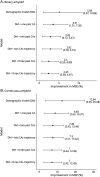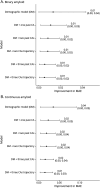Contribution of Global Amyloid-PET Imaging for Predicting Future Cognition in the MEMENTO Cohort
- PMID: 38412412
- PMCID: PMC11770678
- DOI: 10.1212/WNL.0000000000208054
Contribution of Global Amyloid-PET Imaging for Predicting Future Cognition in the MEMENTO Cohort
Abstract
Background and objectives: Global amyloid-PET is associated with cognition and cognitive decline, but most research on this association does not account for past cognitive information. We assessed the prognostic benefit of amyloid-PET measures for future cognition when prior cognitive assessments are available, evaluating the added value of amyloid measures beyond information on multiple past cognitive assessments.
Methods: The French MEMENTO cohort (a cohort of outpatients from French research memory centers to improve knowledge on Alzheimer disease and related disorders) includes older outpatients with incipient cognitive changes, but no dementia diagnosis at inclusion. Global amyloid burden was assessed using positron emission tomography (amyloid-PET) for a subset of participants; semiannual cognitive testing was subsequently performed. We predicted mini-mental state examination (MMSE) scores using demographic characteristics (age, sex, marital status, and education) alone or in combination with information on prior cognitive measures. The added value of amyloid burden as a predictor in these models was evaluated with percent reduction of the mean squared error (MSE). All models were conducted separately for evaluating the added value of dichotomous amyloid positivity status compared with a continuous amyloid-standardized uptake-value ratio.
Results: Our analytic sample comprised 510 individuals who underwent amyloid-PET scans with at least 4 MMSE assessments. The mean age at the PET scan was 71.6 (standard deviation 7.4) years; 60.7% were female. The median follow-up was 4.6 years (interquartile range: 0.9 years). Adding amyloid burden when adjusting for only demographic characteristics reduced the MSE of predictions by 5.08% (95% CI 0.97%-10.86%) and 12.64% (95% CI 3.35%-25.28%) for binary and continuous amyloid, respectively. If the model included 1 past MMSE measure, the MSE improvement was 3.51% (95% CI 1.01%-7.28%) when adding binary amyloid and 8.83% (95% CI 2.63%-16.37%) when adding continuous amyloid. Improvements in model fit were smaller with the addition of amyloid burden when more than 1 past cognitive assessment was included. For all models incorporating past cognitive assessments, differences in predictions amounted to a fraction of 1 MMSE point on average.
Discussion: In a clinical setting, global amyloid burden did not appreciably improve cognitive predictions when past cognitive assessments were available.
Trial registration information: ClinicalTrials.gov Identifier: NCT02164643.
Conflict of interest statement
The authors report no relevant disclosures. Go to
Figures




References
-
- Agdeppa ED, Kepe V, Liu J, et al. . Binding characteristics of radiofluorinated 6-dialkylamino-2-naphthylethylidene derivatives as positron emission tomography imaging probes for beta-amyloid plaques in Alzheimer's disease. J Neurosci. 2001;21(24):RC189. doi:10.1523/JNEUROSCI.21-24-j0004.2001 - DOI - PMC - PubMed
MeSH terms
Substances
Associated data
Grants and funding
LinkOut - more resources
Full Text Sources
Medical
Miscellaneous
